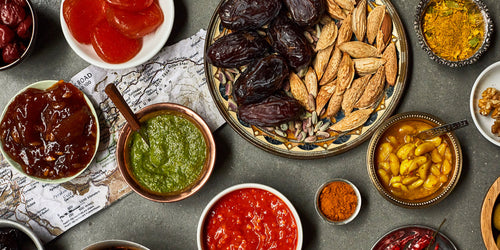Your Cart is Empty
Soy sauce is not a monolith.
Think of it more like vinegar—you wouldn’t swap lean, tart cider vinegar for a syrupy balsamic, would you? Soy sauce is just the same, a whole category of condiments with different styles for different uses. There’s light, delicate white shoyu ideal for sashimi; rich and hearty dark soy sauce for Chinese braises; even “sweet” soy sauces with a texture and flavor approaching barbecue sauce.
It’s easy to get lost in the tangle of names and varieties, even if you grew up with a pantry full of the stuff. Here’s a guide to help you find the right soy sauce (or shoyu, or ganjang, or soya sauce) for the job.
What is soy sauce and how is it made?
Chinese brewers first invented soy sauce over 2,000 years ago. Yes—brewers. Like sake, beer, and wine, soy sauce is a fermented food. Traditionally, soy sauce is made by cooking whole soybeans and crushed wheat into a thick paste, then inoculating the murky mash with Aspergillus mold. In Japanese, that mold is called koji, and it’s also used to make miso paste and sake.

Once the mash is good and bubbling, the brewer adds a salt paste or brine to boost the salinity and help the mold break down the beans and grains into amino acids and sugars that define the sauce’s base flavors. From there, the brewer presses out the solid mash and transfers the strained liquid to a clay urn, wooden barrel, or steel tank to age. Longer aging leads to deeper flavor and extra complexity, just like wine or balsamic vinegar.
That’s a lot of work for an everyday condiment. But of course, not all soy sauce is created equal. Many modern manufacturers eschew that labor-intensive traditional methods for a shortcut involving acid-hydrolyzed vegetable proteins (mmm, delicious) that only takes days to brew, rather than months or years. To our taste buds, these industrial sauces are pale imitations of the real thing.
Fortunately these industrial brews easy to spot. Check your bottle’s ingredients; if you see anything besides soy beans, wheat, salt, and mold cultures on the label, such as caramel coloring and “natural flavors,” steer clear.
Do I need to refrigerate soy sauce?
Soy sauce is designed to last a long time in a range of climates. After all, it’s a method of preserving soybeans! If you go through a bottle within a couple months, it’s fine to store in a cool, dark, and dry place with no risk of spoiling. That said, the flavor will slowly degrade over time, so if you only restock your soy sauce every year or so, move it to the fridge to prolong its lifespan.
Soy sauce styles to know and love
Light soy sauce
Also called “thin soy sauce,” this is your workaday bottle for meat and vegetable stir fries, noodle and rice recipes, and delicate Japanese fish dishes. Koikuchi shoyu is a balanced soy sauce with naturally sweet notes and usually a lower salinity. It’s great for Japanese recipes and raw-fish items like sushi and sashimi, but will also work well in Chinese recipes that call for light soy sauce. Chinese light soy sauce (which may just be labeled as “soy sauce”) tends to be a bit rougher: more salt, less sweet, and a piquant umami bite. But take note: “light” doesn’t mean fewer calories or lower sodium. Lower sodium soy sauces will advertise themselves as such right on the label. Shop Chinese light soy sauce.
Dark soy sauce
Dark soy sauces from China have a texture closer to molasses and may contain sugar to enhance their texture. This style is noticeably less salty and more sweet than light soy sauce, and the two can’t be substituted for each other in recipes. But dark soy sauce’s heavier character is just the thing for hearty, long-simmered meat dishes like red-cooked pork and braised chicken with mushrooms. Many recipes also call for a bit of dark and light soy sauce to get the best of both bottles, just like a cookie recipe that calls for brown and white sugars. Shop Chinese dark soy sauce.
White soy sauce
White shoyu from Japan isn’t white per se, but it’s certainly paler than light soy sauces. It has a lean body and crisp, clean flavor with a little less umami and more sweetness, plus it won’t discolor other ingredients as much. Because it’s so delicate, we recommend using white soy sauce as a finishing accent like a fine extra-virgin olive oil, or as a dipping sauce for sushi and sashimi. Shop Japanese white soy sauce.
Tamari
A by-product of miso paste, tamari has become popular in recent years as a gluten-free alternative to soy sauce for those with wheat sensitivities. Like most Japanese-style soy sauce, it’s less salty than Chinese styles, and has a certain rich character that’s delicious with poultry recipes. But people with gluten sensitivities should be careful: not all tamari is completely gluten-free; many bottles simply contain less wheat than standard soy sauces, so always check the ingredient label. Our Yamasa tamari is certified gluten-free. Shop gluten-free tamari.
Vintage soy sauce
Traditional soy sauces are always aged at least six months to a year, but just like fine vinegars, vintage soy sauces can be aged even longer for greater richness and complexity. Because of the extra care and time that go into making them, aged soy sauces cost more than standard styles, but are still pretty affordable for such a luxurious ingredient. A little goes a long way. Add a few dabs as a finishing touch to anything from grilled steak to steamed fish with ginger and scallion. Shop three- and five-year aged soy sauce.
Smoked soy sauce
Bolstering soy sauce with potent flavors like dried mushrooms or fragrant citrus is hardly new, but in the past few years we’ve seen a boom in one particular kind of flavored soy sauce: smoked. These premium soy sauces, mostly from Japan and Korea, are smoked over a variety of woods and have notes of cask-aged whiskey and barbecued brisket. They’re fantastic dipping sauces and add a nice dimension to cold noodle dishes like soba. Shop cherry- and mizuna-smoked soy sauce.
Sweet soy sauce (aka kecap manis)
An Indonesian style of soy sauce that’s worked its way across Southeast Asian dishes and cuisines, kecap manis is a condiment all its own. Dark sugar and other natural thickeners give it a barbecue sauce consistency, and it’s more smoky and sweet than salty, with a bonus touch of mild fermented funk. It’s traditionally used in Indonesian and Malaysian stir fries and fried-rice dishes like nasi goreng, but it’s also a handy marinade ingredient, and it helps bring body to any brown sauce that needs a flavor boost. Shop sweet soy sauce.
Coconut aminos
Made from fermented palm sap, coconut aminos are decidedlynot soy sauce, but their amber color, kick of salt, and umami backbone fill a similar role in cooking. Coconut aminos have much less salt than classic soy sauces, and are a handy alternative flavoring for those on low-sodium diets. Shop coconut aminos.
Get cooking with these soy-saucy recipes
Recipe: Chrissy Tiegen’s chicken satay
Recipe: Spicy beef dumplings
Recipe: Drunken chicken in shochu sauce
Recipe: Salmon hijiki rice












